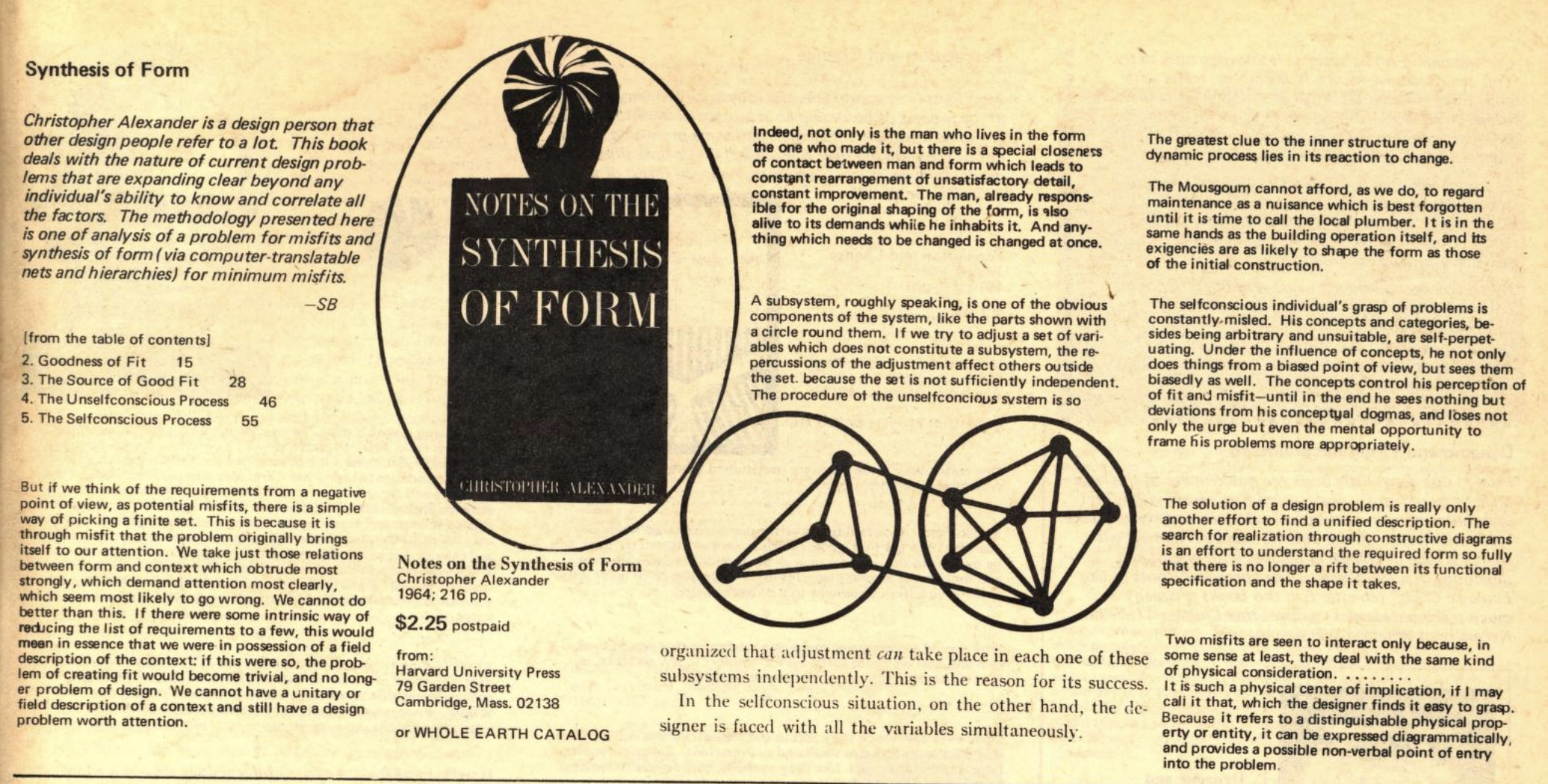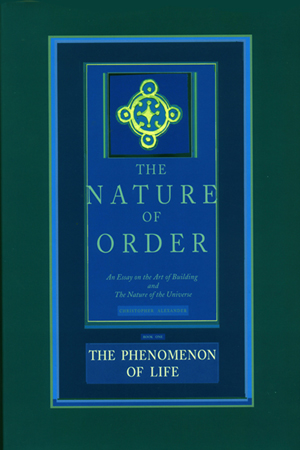Christopher Alexander
30 Oct 2021 - 09 Oct 2025
- Architect and design Theorist. Best known for his book A Pattern Language which introduced the idea of design patterns, later picked up on by the software field.
- Here's an entry from an early Whole Earth Catalog about his first book, on design theory.
- Later he released a four-volume set of books on his radical conception of the universe, Nature of Order. Alexander's search for quality of life in architecture led him to a new theory of everything; of the universe itself as a system of living centers.
The books offer a view of a human-centered universe, a view of order, in which the soul, or human feeling and the soul, play a central role.
Taken as a whole the four books create a sweeping new conception of the nature of things which is both objective and structural (hence part of science) - and also personal (in that it shows how and why things have the power to touch the human heart). A step has been taken, through which these two domains - the domain of geometrical structure and the feeling it creates - kept separate during four centuries of scientific thought, have finally been united.
- This kind of thing is quite a challenge to my materialism. Alexander's case for something closer to vitalism – that life is not an accident of evolution but fundamental to the structure of the cosmos – is made compelling through the sheer beauty of the examples he gives and the thoroughness of his exploration of the questions.
- Further reading
- Patterns of Software, Richard Gabriel, one of the few software people who actually seems to appreciate what Alexander is trying to do.
- Christopher Alexander’s Battle for Beauty in a World Turning Ugly (good introduction and review)
- A Pattern of Abuse (sneering from mainstream architects, interesting to see how CA is viewed from within the field)
Alexander the anarchist
- Or more accurately, a decentralist. The image I have of Alexander's philosophy of architecture is that aesthetics is a distributed field, and good architecture requires that the activity of architecture be distribtued. A central rational authority (architect in the modern sense) is death, good (living) art and architecture relies on being structured as a kind of distributed hierarchy of centers, both the result and the activity of constructing it.
Notes on Notes On Synthesis of Form
- from old notes, 2018. Didn't get far!
Chapter 1 Intro Design is hard, because there are a great many interests and constraints to be reconciled. Furthermore the pace of technical and social changfe is much faster so there is less opportunity to rely on compiled traditional design practices, as earlier generations could. Talks a lot about cognitive limits, and tools for extending those limits (analogy to using pencil and paper for arithamatic, as opppsoed to doing problems in the head) > Two minutes with a pencil on the back of an envelope lets us solve problems which we could not do in our heads if we tried for a hundred years. But at present we have no corresponding way of simplifying design problems for ourselves. (p6) > These notes describe a way of representing design problems which makes them easier to solve. Hm, OK, that is a strong claim that a useful tool is being presented. Some stuff on math and logic, mostly reassuring the artists. But he is quite clear about what the function of logic and representation is, and what it implies. > The use of logical structures to represent design probnlems has an important consequence. It brings with it the loss of innocence A logical picutre is easier to criticize than a vague picture since the assumptions it is based on are brought out into the open. > We must face the fact that we are on the brink of times when man may be able to magnify his intellectual and inventival capability, just as in the nneteenth centryty he used machines to magnifgy his physical capacity. (p 11)
Chapter 2 Goodness of Fit Fit is the corresponence of form to its context. This sounds like me on software: > We should always expect to see the process of achieving good fit between two entities as a negative process of neutralizing the incongruities or irritants, or forces, which cause misfit (p24)
Chapter 3 Source of Good Fit Architecutre in simple cultures tends to have both clarity and goodness of fit, beause their contexts are simple enoujgh. Self-consicous (complex) cultures can՚t build the way they do.
Random
There are thus two worlds in our minds. One is the scientific world which has been pictured through a highly complex system of mechanisms. The other is the world we actually experience. These two worlds, so far, have not been connected in a meaningful fashion. Alfred North Whitehead, writing about 1920, was one of the first philosophers to draw attention to this modern problem, which he called the bifurcation of nature. Whitehead believed that we will not have a proper grasp of the universe and our place in it, until the self which we experience in ourselves, and the machinelike character of matter we see outside ourselves, can be united in a single picture. I believe this. – Christopher Alexander, The Luminous Ground, p13
... It is this ongoing rift between the mechanical-material picture of the world (which we accept as true) and our intuitions about self and spirit (which are intuitively clear but scientifically vague) that has destroyed our architecture. It is destroying us, too (p18)
- Ooh Someone made a web version of A Pattern Language, very useful APL - Home
- On occasion of his death (March 2022). Here's a good one: 43 University As Marketplace
- At Any Given Moment in a Process - by Dorian Taylor
- Really nice overview of Alexander's career and thought.
- Talk by the author on applying CA design ideas (65) Intentionally Intensional Information Architecture — Dorian Taylor - YouTube
- Ooh:
Those who are familiar with such matters will note that Alexander is describing an algorithm. The fundamental differentiating process is an outer loop, and the fifteen properties/transformations are primitives. Alexander treated the building site itself as an analog computer, using the information embedded in its current state at any moment to compute the next step in the process. In a way it reaches back to his earliest mathematical work, circumventing the problem of gathering and partitioning a snarl of design concerns, by performing the computation in situ.
In construction, the convention is that the blueprints are the supreme authority on whether or not this or that constituent of the process did their job. In many jurisdictions, this fact is actually enshrined in statute. Alexander’s method eschewed committing to the precise geometry of the intended outcome, because that was precisely what got revealed throughout his idiosyncratic construction process. In other words, any drawing of a building Alexander drew was only ever a suggestion. Subcontractors and planning authorities, accustomed to authoritative blueprints, simply couldn’t understand it.
- Above are very interesting and resonates with the situated action distinction between plans as programs and plans as recipes to guide improvised conduct. Alexander is advocating jazz architecture!
- Christopher Alexander's architecture for learning
It [APL] is a peculiar tome: a choose your own adventure for how to build a modern medieval city-state.

